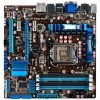- Qualcomm Launches Snapdragon 4 Gen 2 Mobile Platform
- AMD Launches Ryzen PRO 7000 Series Mobile & Desktop Platform
- Intel Launches Sleek Single-Slot Arc Pro A60 Workstation Graphics Card
- NVIDIA Announces Latest Ada Lovelace Additions: GeForce RTX 4060 Ti & RTX 4060
- Maxon Redshift With AMD Radeon GPU Rendering Support Now Available
ASUS P7H55D-M EVO & Intel DH55TC

With Intel’s recent Clarkdale processor launch, the itch to build that new HTPC is no doubt greater than ever. Not only does Intel offer a wide-range of processors, but motherboard vendors are currently offering an incredible amount of H55 models. We’re taking a look at two here, Intel’s own DH55TC and ASUS’ P7H55D-M EVO.
Page 7 – System: PCMark Vantage
Futuremark is no stranger to most any enthusiast out there, as the company’s benchmarks have been used to gauge our PC’s worth for many years. Although the company’s 3DMark Vantage (which we also use for testing) is arguably more popular than PCMark Vantage, the latter is a great tool to measure a system’s overall performance across many different scenarios.
Unlike SYSmark, PCMark is more of a synthetic benchmark, as very little is seen to the user during the run. However, each test tackles a specific and common scenario that’s typical of many computer users – enthusiasts and regular users alike – such as photo manipulation, gaming, music conversion, productivity, et cetera.
The main problem right now with PCMark is its inability (at least for us) to produce an overall score when being run under Windows 7. Even when run in compatibility mode (which is required by 3DMark), the application will crash during the Memories test, despite that particular test executing fine when run as its own suite. So, no overall score is produced, but the seven individual scores are.
While SYSmark uses modest numbers for their scoring, ranging in the hundreds, Futuremark opts for much higher scores with their entire suite, with the lowest being the TV and Movies, ranging around the 6,000 mark. On the high-end, our Intel SSD is capable of pushing the test’s HDD scenario well beyond 20,000.

Intel’s board may have come a bit ahead in our SYSmark run, but ASUS struck back and placed ahead of Intel in PCMark. Overall, each test sways a fair bit from run to run, but both boards overall perform extremely well.
Support our efforts! With ad revenue at an all-time low for written websites, we're relying more than ever on reader support to help us continue putting so much effort into this type of content. You can support us by becoming a Patron, or by using our Amazon shopping affiliate links listed through our articles. Thanks for your support!






